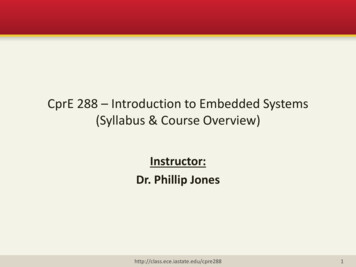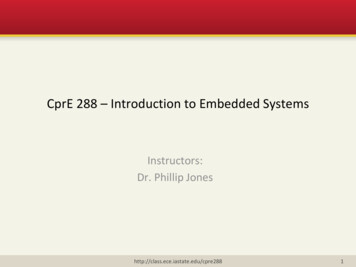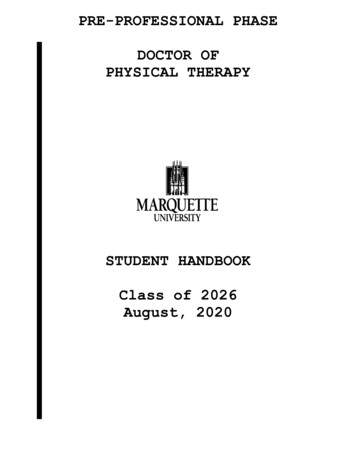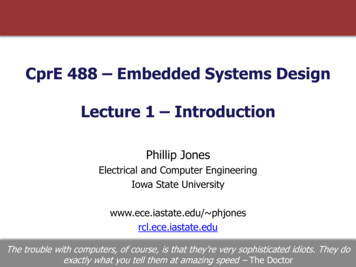
Transcription
CprE 288 – Introduction to Embedded Systems(Syllabus & Course Overview)Instructor:Dr. Phillip Joneshttp://class.ece.iastate.edu/cpre2881
Overview of Today’s Lecture AnnouncementsSyllabusCourse OverviewWarmup reviewhttp://class.ece.iastate.edu/cpre2882
Announcements HW 1: Due Sunday (5/22) Quiz 1: Fri (5/20) – First 10 minutes of class using Canvas– First week of class lectures– Note: No materials or Calculator allowed for Quiz 1http://class.ece.iastate.edu/cpre2883
Announcements Labs start this week (platform overview) http://class.ece.iastate.edu/cpre288 (class website)http://class.ece.iastate.edu/cpre2884
SYLLABUShttp://class.ece.iastate.edu/cpre2885
Syllabus Policies LaboratoryLectureHomeworkAcademic HonestyClassroom Conducthttp://class.ece.iastate.edu/cpre2886
Syllabus Laboratory Policy Lab attendance: is mandatory, unexcused absence results in a 0 forthat lab Teamwork: labs are partner activities (no exceptions) Emergencies: inform instructor and your TAs prior to the start of lab Labs and a lab project (e.g. Solve a real-world problem)– Prelab, if given, must be completed before start of lab session– Lab demo is due at the beginning of lab the following week TA will check them off during the first 5 minutes of Lab Location: All lab sections located in Coover 2041http://class.ece.iastate.edu/cpre2887
Syllabus Lecture Policy Lecture attendance:– In-class exercises are a component of your grade Part of course participation grade– In-lecture activities are for reinforcing course content. Quizzes: Typically a Canvas quiz at the beginning of lecturetwice a weekhttp://class.ece.iastate.edu/cpre2888
Syllabus Homework Policy Weekly assignments: To keep mind active and to reinforce lecture Collaboration: Study groups encouraged for enhancing learning– ALL collaborators must be documented on HW– Specifically what and how collaboration was done must be given– Copying and/or not specifying how collaborated is considered aviolation of academic integrity (see syllabus for details) Typed: homework answers are required to be typed Submission: Use Canvas for HW submission (PDF or Word only) Late Policy: Homework can be turned in up to two days late for a10% per day deduction. Homework given a 0 after this point. Avoiding violations of Academic conduct: It is highly recommendedthat you first work through all problems on your own beforecollaborating with others to further improve you 9
Syllabus Academic Honesty Work independently on exams Seek peer help to better your knowledge and skillsrather than your grades Do not borrow/copy code from others. Example good questions to ask:– “Could you explain how pointers work?”– “I don’t understand this io t struct. What is it?”– “Can you explain successive 28810
Syllabus Academic Honesty Examples of bad questions/actions that violateAcademic Conduct polices:– “Can you show me your answer for question 3?”– “Can you e-mail me your homework?”– “E-mail me your source code for taking a Sonarmeasurements”– “If I do homework question 1, will you do question 2 and thenwe can trade?”http://class.ece.iastate.edu/cpre28811
Syllabus Academic Honesty The following acts are considered a violation of the University’sstudent conduct policy (not exhaustive). Offenders will bereported to the Dean of Students Office.http://catalog.iastate.edu/academic conduct/#academicdishonestytext– Sending or receiving any fragment of source code from another group, orfrom someone who previously took the class, is an offense.– Sending or receiving answers to homework assignments is an offense.– Copying answers to homework problems from others is an offense.– Copying answers from another person’s exam is an offense. Infractions of academic honesty will result in a minimum of a zeroon that assignment and may, at the discretion of the instructor, anF for the course.http://class.ece.iastate.edu/cpre28812
Syllabus Code of Classroom Conduct Code of Classroom Conduct summary– Treat all classmates in a respectful manner– Help ensure an inclusive learning environment Detailed Code of Classroom Conduct statement is found 3
Syllabus Grading Breakdown Exams 35%– Exam 1: 10%– Exam 2: 15%– Exam 3: 10% Quizzes: 10% Homework: 10% Class Participation: 5%– In class exercises– Reflections Laboratory Exercises: 25%– laboratory exercises Laboratory Project: 15%http://class.ece.iastate.edu/cpre28814
Syllabus Exams Exam 1 – TBA Exam 2 – TBA Exam 3 – TBA (last day)This schedule is tentative What is allowed– Textbook– Datasheet– Calculator (no internet access)http://class.ece.iastate.edu/cpre28815
Course: High-level phasesThree general phases:Exam 3: (Assembly)Exam 1: (Microcontroller basics) 3 Weeks 5 Weeks– ARM Assembly programming– C for Embedded Systems– Lab Project Demos– Interrupt handling (ISR)– Memory Mapped: I/O, Devices, Registers– Project Platform BasicsExam 2: (Microcontroller Peripherals/Devices) 6 Weeks– Serial (UART)– Distance sensors (IR & Sonar)– Analog to Digital Conversion (ADC)– Timers– Input Capture– Pulse Width Modulation (PWM)http://class.ece.iastate.edu/cpre28816
Course Overview Course Learning Objectives Learn to interface microcontrollers with the real world Learn to enable others to interface microcontrollers withthe real world Learn system-level debugging Learn the computing and data storage structure ofmicrocontrollers Improve systematic learning Become familiar with professional roles in the embeddedsystems fieldhttp://class.ece.iastate.edu/cpre28817
Course: Website Course website: http://class.ece.iastate.edu/cpre288– Primary source for course information, in addition to Canvas Lecture slides Lab descriptions Useful resources Homework posts Detailed Syllabus informationhttp://class.ece.iastate.edu/cpre28818
COURSE OVERVIEWhttp://class.ece.iastate.edu/cpre28819
Course Overview Mindset Course structure will to a degree emulate a company You will be an entry level engineer in this company Through the semester you will:– Define a problem to be solved using an embedded system– Train on the company’s embedded system platform andlearn its technical capabilities and limitations.– Prototype a solution to your defined problem using thecompany’s resources.http://class.ece.iastate.edu/cpre28820
Course Overview Embedded Systems Int. (ESI) Mission Statement: Embedded Systems International strivesto combine engineering knowledge with embedded systemstechnology to solve a wide range of problems. As part of ourcharter, we place great value on communicating to the publicat large the motivations for the projects we undertake, theirinherent challenges, and their potential impact.http://class.ece.iastate.edu/cpre28821
Course Overview Embedded Systems Int. (ESI) Mission Statement: Embedded Systems International strivesto combine engineering knowledge with embedded systemstechnology to solve a wide range of problems. As part of ourcharter, we place great value on communicating to the publicat large the motivations for the projects we undertake, theirinherent challenges, and their potential impact.http://class.ece.iastate.edu/cpre28822
Course Overview Embedded Systems Int. (ESI) Mission Statement: Embedded Systems International strivesto combine engineering knowledge with embedded systemstechnology to solve a wide range of problems. As part of ourcharter, we place great value on communicating to the publicat large the motivations for the projects we undertake, theirinherent challenges, and their potential impact.http://class.ece.iastate.edu/cpre28823
Course Overview Embedded Systems Int. (ESI) Mission Statement: Embedded Systems International strivesto combine engineering knowledge with embedded systemstechnology to solve a wide range of problems. As part of ourcharter, we place great value on communicating to the publicat large the motivations for the projects we undertake, theirinherent challenges, and their potential impact.http://class.ece.iastate.edu/cpre28824
Course Overview Embedded Systems Int. (ESI) Mission Statement: Embedded Systems International strivesto combine engineering knowledge with embedded systemstechnology to solve a wide range of problems. As part of ourcharter, we place great value on communicating to the publicat large the motivations for the projects we undertake, theirinherent challenges, and their potential impact.http://class.ece.iastate.edu/cpre28825
Course Overview Embedded Systems Int. (ESI) Mission Statement: Embedded Systems International strivesto combine engineering knowledge with embedded systemstechnology to solve a wide range of problems. As part of ourcharter, we place great value on communicating to the publicat large the motivations for the projects we undertake, theirinherent challenges, and their potential impact.http://class.ece.iastate.edu/cpre28826
Course Overview Embedded Systems Int. (ESI) Mission Statement: Embedded Systems International strivesto combine engineering knowledge with embedded systemstechnology to solve a wide range of problems. As part of ourcharter, we place great value on communicating to the publicat large the motivations for the projects we undertake, theirinherent challenges, and their potential impact.http://class.ece.iastate.edu/cpre28827
Course Overview Embedded Systems Int. (ESI) Mission Statement: Embedded Systems International strivesto combine engineering knowledge with embedded systemstechnology to solve a wide range of problems. As part of ourcharter, we place great value on communicating to the publicat large the motivations for the projects we undertake, theirinherent challenges, and their potential impact.In what areasare you interested?http://class.ece.iastate.edu/cpre28828
Course Overview Embedded Systems Int. (ESI) Mission Statement: Embedded Systems International strivesto combine engineering knowledge with embedded systemstechnology to solve a wide range of problems. As part of ourcharter, we place great value on communicating to the publicat large the motivations for the projects we undertake, theirinherent challenges, and their potential impact. Next 8 weeks: You will be trained and will make use ofthe ESI development platform to prototype anembedded system product to solve a problem that couldrange from local to global societally scope.http://class.ece.iastate.edu/cpre28829
Course Overview Employee RoleESI has high expectations of our junior engineers. As a memberof a team, you will be responsible for carrying out the followingroles in your project:– 1) gaining a clear understanding of what are the needs of yourcustomer and the degree to which your solution addressestheir needs,– 2) learning how to use ESI’s technology and gaining a clearunderstanding of the capabilities and limitations of thetechnology, and– 3) prototyping your solution using ESI’s technology.http://class.ece.iastate.edu/cpre28830
Course Overview PlatformCyBot: is the codename for ESI’s embedded systemsplatform. It is a programmable mobile system composedof various sensors for solving embedded system problemshttp://class.ece.iastate.edu/cpre28831
Course Overview Typical week on the jobEach week you will be responsible for learning andapplying an aspect of the ESI platform to enable you toimplement a fundamental capability of your product. Thistraining process will involve you:– 1) Reading and understanding the written documentationassociated with a given aspect of the platform,– 2) Attending training sessions related to that aspect, and– 3) Demonstrating your proficiency in using that aspect throughcompleting hands-on training assignments.http://class.ece.iastate.edu/cpre28832
Course Overview Example Problem Mars Exploration: NASA needs a way to investigate thesurface of Mars. ESI solution: The Cybot platform will be used to developa prototype of a Mars Rover that can:1)2)3)4)Avoid obstaclesCollect data about the Martian terrainStay within a radiation safe zoneNavigate to a communication rely station to send findingsback to Earth Prototype: Fully Autonomous Mars Roverhttp://class.ece.iastate.edu/cpre28833
Course Overview First Week Outlook What are you excited about? What concerns do you have?http://class.ece.iastate.edu/cpre28834
Reflection QuestionTake 2 minutes to think about and respond these questions: What is your view of the role of CPRE 288 in your curriculumobjectives? What do you believe will be the biggest challenge in this classfor you?http://class.ece.iastate.edu/cpre28835
EMBEDDED SYSTEMShttp://class.ece.iastate.edu/cpre28836
Methods for Representing Data Bit– 1 (True)– 0 (False) Nibble (less commonly used)– 4 bits Byte– 8 bits N-byte Words– 2-byte / 16-bit Word, 4-byte / 32-bit Wordhttp://class.ece.iastate.edu/cpre28837
Methods for Representing Data Three of the most common forms of notation– Decimal (base 10)– Hexadecimal (base 16)– Binary (base 2)01234567890123456789ABCDEF01 Converting between forms– When converting binary to hexadecimal, every group of 4 bits(nibble) represents a hexadecimal digit– ass.ece.iastate.edu/cpre28838
Base Conversion (by hand) Base n to base 10Problem: Convert base 2: 0b0100 1011, to base 10Solution:2726252423222120128’s 64’s 32’s 16’s8’s4’s2’s1’s0100101164 8 2 1 75http://class.ece.iastate.edu/cpre28839
Base Conversion (by hand) Base 10 to base nProblem: Convert 175 to base 16Solution:Create a table of the columns in a base 16 number andsubtract from the original number:16116016116016’s1’s 175 – 160 8840
Base in C Syntax in C– Computers understand binary– The following lines of code are all the same (the complier doesnot care what base the programmer uses):char x 2 1;char x 0b10 1;char x 0x2 1;char x 0x02 0x01;http://class.ece.iastate.edu/cpre28841
What are Embedded Systems?Quadcopter Your Definition?Micro SD Card? What are some propertiesof an Embedded System?Blu-Ray / te.edu/cpre288Roomba42
ENDhttp://class.ece.iastate.edu/cpre28843
Course Overview Embedded Systems Int. (ESI) Mission Statement: Embedded Systems International strives to combine engineering knowledge with embedded systems technology to solve a wide range of problems. As part of our charter, we place great value on communicating to the public at l










